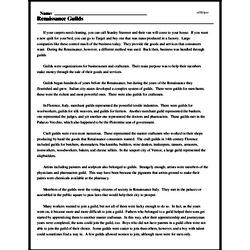Renaissance Guilds
If your carpets need cleaning, you can call Stanley Steemer and their van will come to your house. If you want a new quilt for your bed, you can go to Target and buy one that was mass-produced in a factory. Large companies like these control much of the business today. They provide the goods and services that consumers want. During the Renaissance, however, a different method was used. Back then, business was handled through guilds.
Guilds were organizations for businessmen and craftsmen. Their main purpose was to help their members make money through the sale of their goods and services.
Guilds began hundreds of years before the Renaissance, but during the years of the Renaissance they flourished and grew. Italian city-states developed a complex system of guilds. There were guilds for merchants; these were the richest and most powerful ones. There were also guilds for craftsmen.
In Florence, Italy, merchant guilds represented the powerful textile industries. There were guilds for woolworkers, guilds for silk weavers, and guilds for furriers. Another merchant guild represented the bankers, one represented the judges, and yet another one represented the doctors and pharmacists. These guilds met in the Palazzo Vecchio, which also happened to be the Florentine seat of government.
Craft guilds were even more numerous. These represented the master craftsmen who worked in their shops producing by hand the goods that Renaissance consumers wanted. The craft guilds in 14th century Florence included guilds for butchers, shoemakers, blacksmiths, builders, wine dealers, innkeepers, tanners, armorers, ironworkers, woodworkers, bakers, and cheese sellers. In the seaport city of Venice, a large guild represented the shipbuilders.




